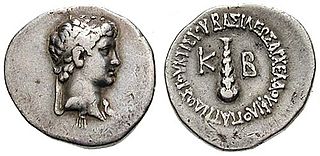
Nevalı Çori was an early Neolithic settlement on the middle Euphrates, in Şanlıurfa Province, Southeastern Anatolia, Turkey. The site is known for having some of the world's oldest known temples and monumental sculpture. Together with the earlier site of Göbekli Tepe, it has revolutionised scientific understanding of the Eurasian Neolithic period. The oldest domesticated Einkorn wheat was found there.
Tushhan is a Kurdish village known as or by residents. It was an ancient city in Mesopotamia and was a provincial capital in the upper Tigris river valley, on the south bank and inhabited since the Mitanni period, and mainly during the Neo-Assyrian period during the Iron Age.

Archelaus was a Roman client prince and the last king of Cappadocia.

Alishar Hüyük was an ancient Near Eastern city. It is near the modern village of Alişar, Sorgun.

Hypenodes is a genus of moths of the family Erebidae erected by Henry Doubleday in 1850.

Chersotis larixia is a moth of the family Noctuidae. It is found in Spain, France, Switzerland, Italy and Sicily, Crete, Turkey, and east to Armenia, Azerbaijan, Syria, Iran, Lebanon, and Turkmenistan. In Europe, it is found in mountainous regions, like the Pyrenees, the Alps, and the Maritime Alps, up to heights of 2,000 meters.

Chamaesphecia is a genus of moths in the family Sesiidae.

Hypenodes humidalis, the marsh oblique-barred, is a moth in the family Erebidae. The species was first described by Henry Doubleday in 1850. It is found in most of Europe and across the Palearctic to Siberia.
Hypenodes caducus, the large hypenodes moth, is a species of moth in the family Erebidae. It was described by Harrison Gray Dyar Jr. in 1907. It is found in North America, including British Columbia, Maryland, Massachusetts, Michigan, Minnesota, New York, Ohio, Ontario, Quebec, South Carolina and Wisconsin.
Hypenodes fractilinea, the broken-line hypenodes, is a moth in the family Erebidae. The species was described by John B. Smith in 1908. It is found from Nova Scotia south to North Carolina, west across Canada to Alberta. The habitat consists of mixed wood and deciduous woodland.
Hypenodes franclemonti is a species of moth in the family Erebidae. It was described by Douglas C. Ferguson in 1954. It is found in North America, including Florida, Michigan, Minnesota, Missouri, Pennsylvania and Quebec.
Hypenodes orientalis is a species of moth in the family Erebidae. It was described by Staudinger in 1901. It is found in Turkey, the Near East, Armenia and the southern Caucasus.
Hypenodes palustris is a species of moth in the family Erebidae. It was described by Douglas C. Ferguson in 1954. It is found in North America, including Alaska, Maryland, Minnesota, New Brunswick, Nova Scotia, Ontario, Quebec and Wisconsin.
Hypenodes sombrus is a species of moth in the family Erebidae. It was described by Douglas C. Ferguson in 1954. It is found in Canada from Nova Scotia to western Alberta. The habitat consists of bogs, cattail marshes, dry pine and other woodlands.

Dyspessa is a genus of moths belonging to the family Cossidae. It was described by Jacob Hübner in 1820.
Chelis reticulata is a moth in the family Erebidae. It was described by Hugo Theodor Christoph in 1887. It is found in the Caucasus, Transcaucasia, Armenia, the Kopet Dagh, Asia Minor, Syria, northern Lebanon and northern Iran.

Morchella anatolica is a rare species of ascomycete fungus in the family Morchellaceae. It was described as new to science in 2010 from southwest Anatolia, Turkey, where it grows on moss-covered stream beds in pine forests. An ancient climatic relict, M. anatolica is restricted to the Mediterranean basin and has also been documented in Spain, Cyprus and Greece, where it is sometimes encountered with trees of the Oleaceae family. Together with its sister-species Morchella rufobrunnea, they are the earliest diverging lineages in genus Morchella, forming a distinct clade that is basal in global morel phylogenies. Because of its phylogenetic position, M. anatolica has been crucial in inferring the historical biogeography of the genus, which is estimated to have emerged somewhere in the Mediterranean region in the late Jurassic.
Apatophysis is a genus of longhorn beetles in the subfamily Dorcasominae.

The Hypenodinae are a subfamily of moths in the family Erebidae. Adult moths of most species of this subfamily lack small, simple eyes near the large, compound eyes and have quadrifine (four-veined) hindwing cells. The micronoctuid moths are an exception because they possess simple eyes and bifine (two-veined) hindwing cells.








